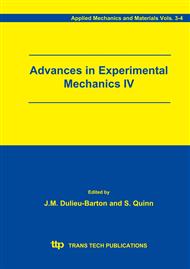p.3
p.9
p.17
p.27
p.33
p.39
p.47
p.53
p.59
Elastic-Plastic Behaviour of a Plate with a Central Hole by Photoelastic Coating Method
Abstract:
An application of the elastic-plastic problem by the photoelastic coating method is presented in this paper. A general procedure of this experiment, such as image processing and separation of the difference of principal strain to obtaine stresses from isochromatic fringes is referred. The methodology to extract centre lines of coloured isochromatic fringes is explained. Experiments are conducted with cross-shaped aluminum specimens with a circular hole subjected to uniaxial tension and equi-biaxial tension. Results of image processing are shown, and the distribution of difference of principal strains and separated principal strain are shown in the case of equi-biaxial tension.
Info:
Periodical:
Pages:
27-32
Citation:
Online since:
August 2006
Authors:
Price:
Сopyright:
© 2005 Trans Tech Publications Ltd. All Rights Reserved
Share:
Citation:


